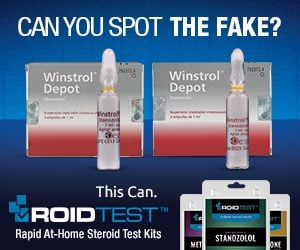The human body naturally endogenously manufactures a T3 dosage of approximately 30mcg per day. Hence, this is why many users who wish to ‘play it safe’ by starting off at a Cytomel dosage of 25mcg per day are actually taking a step backwards in progress rather than moving forwards. T3 doses of 25mcg per day are actually less than is normally manufactured by the human body. This attempt at ‘playing it safe’ by utilizing a very small T3 dosage at the beginning is the result of the fear that has been propagated by individuals among the performance enhancing drug using community that T3 is a very dangerous drug, when in reality it is no more dangerous than most other hormonal drugs, such as anabolic steroids.
What also needs to be addressed in this profile is the concept of a slow titration upwards (a slow ramping upwards) of T3 doses, which has become an extremely popular practice that is for the most part unnecessary. The claims made by individuals among the performance enhancing drug using community concerning the ramping up of the Cytomel dosage is that the thyroid gland is a very sensitive gland that can potentially become permanently shut down if Cytomel doses are raised either too fast, or too high. These claims, once again, are wrong and are not supported by clinical evidence. For over 2 decades, one of the myths that has persisted in regards to T3 has been the myth of permanent thyroid gland damage.
The truth and reality of the matter is that the thyroid gland operates just like any other endocrine gland in the human body. The thyroid gland, in fact, has been found to be one of the endocrine glands that possesses the slowest response to the negative feedback loop. It has been found in a couple of particular clinical studies that patients who were placed on T3 for many years had recovered their endogenous thyroid hormone production within a matter of weeks, and in fact some of these patients were administered T3 for thirty years after having been removed from the medication due to being misdiagnosed[1] [2]. All test subjects within the aforementioned clinical studies recovered their thyroid function within very short time periods.
The study specifically reads,
The pattern of thyrotropin secretion was analyzed in seven euthyroid women, before and after withdrawal of long-term thyroid hormone, by serial measurements of thyroid 131l uptake, serum thyroxine, tri-iodothyronine, and thyrotropin concentrations, and the response to thyrotropin-releasing hormone. During exogenous hormone administration, 131l uptake was suppressed, and serum thyrotropin concentrations before and after administration of thyrotropin-releasing hormone were undetectable. After withdrawal of exogenous hormone, thyrotropin secretory function was transiently impaired, as indicated by undetectable basal thyrotropin concentrations together with absence of response to thyrotropin-releasing hormone, and subsequently by normal values of basal thyrotropin concentration and normal responses to releasing hormone while serum thyroxine and tri-iodothyronine concentrations were subnormal. Decreased thyrotropin reserve persisted for two to five weeks.Detectable values of serum thyrotropin (less than 1.2 muU per milliliter) and a normal 131l uptake usually occurred concurrently in two to three weeks. Serum thyroxine concentration returned to normal at least four weeks after hormone withdrawal.1
Therefore, claims among the athletic and bodybuilding community that T3 can or will cause permanent thyroid gland damage should not be believed at all. These are merely conjecture and rumors that have been developed over the previous 2 decades or so.
Medical Cytomel (T3) Dosage
For the treatment of hypothyroidism, the normal medical Cytomel dosage is that of a starting dose of 25mcg per day. Following this, the patient assesses his or her reactions and tolerance to the drug and adjusts their Cytomel dosage by no more than 25mcg per day. The average maintenance T3 doses lie between 25 – 75mcg per day. Once the patient’s desired optimal dose is achieved, this dose remains steadily administered for the remainder of therapy.
Cytomel (T3) Dosage For Fat Loss
Bodybuilders and athletes who wish to use T3 for its weight loss and fat loss effects normally begins with a T3 dosage of 25 – 50mcg per day, and tolerance is assessed. Tolerance relates to the experience of metabolism and fat burning effects, as well as the temperature increase associated with it. Every individual will respond in a different manner and a different intensity to any one given Cytomel dosage, so it must be understood that a T3 dose of 50mcg for one individual might elicit steady fat loss, but that same 50mcg dose might not do very much for another.
Once tolerance is assessed after remaining at a 50mcg dose for a day or two, the individual should then increase their Cytomel dosage by an additional 25mcg every day (or every other day, depending on the individual’s experience) until a peak optimal dose is achieved. The typical peak dose for most male bodybuilders and athletes tends to lie in the range of 75 – 100mcg per day. Some have even ventured as high as 125mcg per day, though this is on the high end and is not normally recommended.
Female Cytomel (T3) Dosage
For the most part, the female response to the effects of Cytomel (T3) is the exact same as the male response. The only major difference in Cytomel dosage for females is that of the difference in body weight and mass. Females tend to be of a lower total size, weight, and body mass than men and therefore may tend to be more sensitive to a given T3 dosage.
The peak effective dose for most females should be in the range of approximately 50 – 75mcg per day, with 75mcg being at the uppermost high end.
Proper Administration and Timing of Cytomel (T3) Dosage
T3 exhibits a half-life of 2.5 days, and it is therefore completely unnecessary to split up T3 doses throughout the day, as ingestion of the complete daily Cytomel dosage in the morning is adequate. It is also not completely necessary to titrate (slowly ramp up) the Cytomel dosage upwards. Initially, for the very first use of T3 for an individual, it is recommended to do so in order to obtain a feel for the compound’s effects as well as to gauge the increasing body heat output, as well as any possible muscle loss.
Once an individual is aware of his or her full effective peak optimal dose, it is generally not necessary to slowly ramp up T3 doses, and that starting at the known optimal Cytomel dosage should present no issues.
By the same admission, it is unnecessary to slowly titrate T3 doses downwards at the conclusion of a T3 cycle. The common myth used to be that upon sudden cessation, the thyroid gland can become damaged permanently. This is, once again, simply not true due to the research referenced earlier. It is in fact the best course of action to immediately eliminate all T3 doses at the conclusion of use so as to allow the thyroid hormone to restore function as soon as possible. As long as exogenous thyroid hormones are being administered, the thyroid hormone cannot recover due to the negative feedback loop. This applies even when slowly ramping down Cytomel doses. It is therefore best to cease administration immediately so as to allow function to restore as soon as possible, just as with the use of anabolic steroids.
Expectations and Results from Cytomel (T3) Dosage
T3 is a potent stimulator of the body’s metabolism at the cellular level that does not discriminate between the different substrates being utilized for energy (protein, carbohydrates, and fats). Therefore, it is important to understand that the fat loss can sometimes be dramatic, and if T3 is utilized without anabolic steroids beyond a certain dose (approximately more than 50mcg of T3), muscle loss can occur. The greater the T3 dosage, the greater and quicker the muscle loss can occur.
It is also important for the reader to know and understand that excessive doses of anabolic steroids are absolutely unnecessary for the preservation of muscle during T3 use. A total weekly anabolic steroid use of 300 – 500mg per week (any anabolic steroid) should be more than sufficient for the preservation of muscle and the retention of nitrogen during the use of higher T3 doses. Stronger anabolic steroids such as Trenbolone or Winstrol will stave off muscle loss from T3 at only 200mg per week. The use of excessive anabolic steroid doses merely for the purpose of muscle preservation during T3 use is completely unnecessary.
Cytomel (T3) References:
[1] Recovery of pituitary thyrotropic function after withdrawal of prolonged thyroid-suppression therapy. N Engl J Med 1975 Oct 2;293(14):681-4 Vagenakis AG, Braverman LE, Azizi F, Portinay GI, Ingbar SH.
[2] Patterns off recovery of the hypothalamic-pituitary-thyroid axis in patients taken of chronic thyroid therapy. J Clin Endocrinol Metab 1975 Jul;41(1):70-80 Krugman LG, Hershman JM, Chopra IJ, Levine GA, Pekary E, Geffner DL, Chua Teco GN






